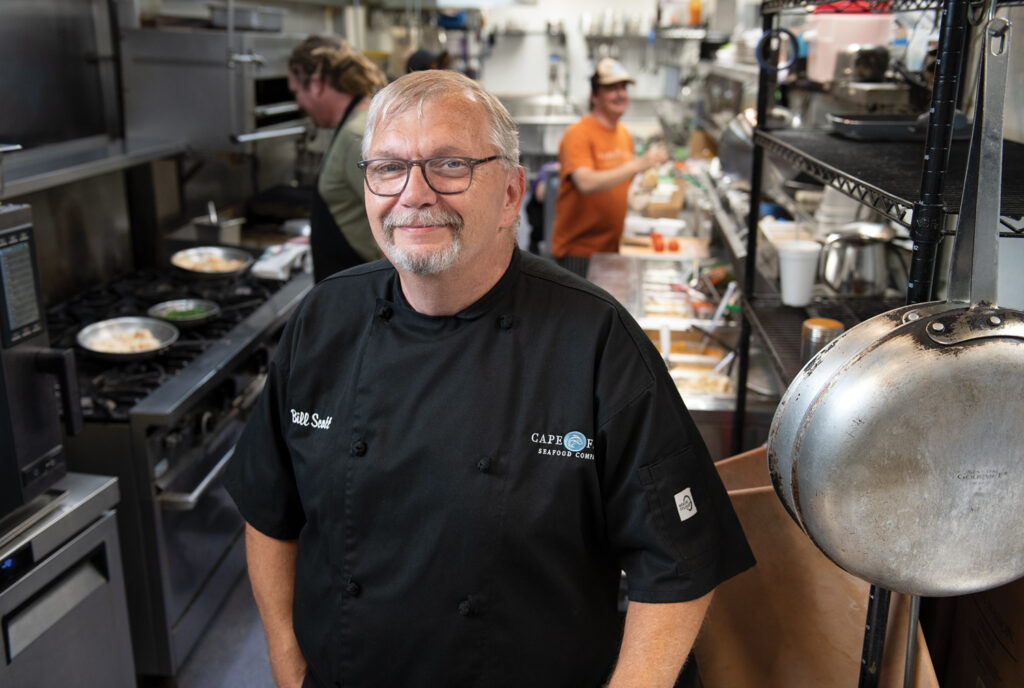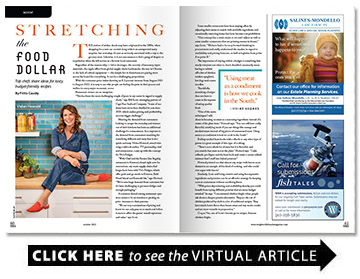Stretching the Food Dollar
Top chefs share ideas for tasty, budget-friendly recipes
BY Fritts Causby

The notion of sticker shock may have originated in the 1980s, when shopping for a new car carried along with it an unexpected nasty surprise, but nowadays it’s just as seriously associated with a trip to the grocery store. Likewise, it is not uncommon to feel a pang of despair or trepidation when the bill arrives at a favorite local restaurant.
Regardless of the reasons why — labor shortages, the scarcity of necessary input materials, the ripple effect from global supply chain bottlenecks, the war in Ukraine or the lack of critical equipment — the simple fact is Americans are paying more across the board for everything. It can be a challenging proposition.
With the consumer price index showing an 8.3 percent increase from August 2021 to August 2022, it is easy to see why people are feeling the pain in their purses and wallets in every major economic sector.
Restaurant owners are no exception.
“This has been the most challenging couple of years in my career in regard to supply chain,” says Bill Scott, managing partner of Cape Fear Seafood Company. “Some of our items have more than doubled in cost since 2020, which makes pricing and profitability an even bigger challenge.”
Meeting the demand from consumers looking to escape the everyday and venture out of their kitchens has been an additional challenge for restaurateurs. As a response to the demand from consumers searching for something different and tasty that is also quick and easy, Vivian Howard, award-winning cookbook author, TV personality, chef and restaurateur, came up with the concept for Viv’s Fridges.
“With Chef and the Farmer [her flagship restaurant in Kinston] closed right now for renovations, my main supply chain challenges have been with Viv’s Fridges, which offer grab-and-go meals in Kinston, Bald Head Island and Emerald Isle,” says Howard. “We’ve seen huge demand from customers but it’s been challenging to get more fridges and enough packaging.”
A common thread among restaurant operators seems to be an aversion to passing on price increases to their patrons.
“We are very conscientious of pricing and know we can only pass on so much cost before it starts to affect the guests’ overall experience and value,” says Scott.
Some smaller restaurants have been staying afloat by adjusting their menu to match with available ingredients and occasionally removing items that have become cost-prohibitive.
“Our concept has a static menu so we can’t adjust as well as some smaller restaurants that are printing menus in-house,” says Scott. “We have had to be very forward thinking in procurement and really understand the market in regard to availability and pricing forecasts, as well as logistics from point A to point B.”
The importance of staying within a budget is something that nearly everyone can relate to, but it shouldn’t necessarily mean having to subsist off a diet of chicken tenders, spaghetti, hot dogs and ramen noodles.
Thankfully, stretching a budget does not have to come at the expense of eating quality food.
“One of the main techniques I talk about is focusing on meat as a seasoning ingredient, instead of a center of the plate item,” Howard says. “You can still have really flavorful, satisfying meals if you use things like sausage and smoked meats instead of big pieces of unseasoned meat. Using meat as a condiment is how we cook in the South.”
Boiling smoked ham hocks with collards or any other type of greens is a great example of this type of cooking.
“There’s not a whole lot of meat but it is flavorful, and you stretch that meat across the plate,” Howard says. “I take collards, pot liquor and the ham hock and create a cream collard mixture that I stuff into baked potatoes.”
Howard pointed out that almost any recipe with bacon as an element is an example of this kind of cooking, and who could ever argue with bacon?
Similarly, Scott said being creative and using less expensive ingredients and proteins can be an effective strategy for keeping costs at a minimum without sacrificing flavor.
“With prices skyrocketing and availability sketchy you could benefit from trying different proteins that are more budget-minded,” he says. “I recommend chicken thighs when people ask about a cheaper protein alternative. They are the cut of chicken preferred by chefs in a lot of traditional recipes. They have much better flavor than breast meat and stay moist, tender and are more versatile in preparation.”
Coq au Vin, one of Scott’s favorite go-to recipes, features chicken thighs.
This sounds fancy but is pretty easy, especially if you’ve precooked your chicken,” he says.
For convenience, Scott recommends baking several meals worth of chicken thighs at a time so they can be used in a variety of different recipes.
“Just rub them with a little oil, salt and pepper, bake in a 350-degree Fahrenheit oven until the internal temperature reaches 165, then refrigerate or freeze until needed. Chicken thighs are always a little pink inside so use a thermometer to be sure,” Scott says.
Chicken thighs are also very flavorful pulled straight out of the package and placed onto a hot grill with a little salt and pepper. They are also the perfect base for chicken adobo.
Sweet Potato, Kraut & Bacon Chowder
Serves 6 (2 cups each)
From Vivian Howard’s 2020 cookbook “This Will Make It Taste Good”
Ingredients
- 12 ounces bacon, cut into bite-size 1-inch squares
- 2 leeks, light green and white parts only, sliced into ½-inch rounds
- 3 stalks celery, sliced (1 cup)
- 2 Tbsp minced fresh ginger
- 4 garlic cloves, sliced thin
- 1 tsp kosher salt
- ½ tsp red pepper flakes
- 2 pounds sweet potatoes, peeled and cut into 1-inch cubes (6 cups)
- 1 pound white potatoes, peeled and cut into 1-inch cubes (3 cups)
- 3 cups sauerkraut, homemade or store-bought, drained
- 8 cups chicken broth
- 2 cups heavy cream
- 2 cups milk
Preparation
In a six-quart Dutch oven over medium heat, render the bacon until crispy or until it’s the way you enjoy it on top of soup. Remove the bacon but leave the fat. Add the leeks, celery, ginger, garlic, salt and pepper flakes. Sweat over medium heat for about 5 minutes.
Add the sweet potatoes, white potatoes, kraut, chicken broth, cream and milk. Cover and bring to a hard simmer. Cook for about 30 minutes, or until the potatoes are beginning to fall apart, then uncover and simmer for another 10 minutes. Working in batches, put the soup in a blender or food processor and carefully blend until smooth. “If you don’t feel like breaking out your blender or you’re happy with the consistency of the soup as is, use a potato masher or a ladle to encourage the potatoes to break up,” says Howard.
Add the blended mixture back into the pot and stir to incorporate. Serve warm with lots of bacon on top.
________
Coq au Vin
(from Bill Scott)
Ingredients
- 3 Tbsp oil
- 2 to 3 slices bacon cut up (optional but adds to the flavor)
- 8 bone-in, skin-on chicken thighs, precooked
- Salt and black pepper
- 1 large yellow onion, roughly chopped
- 4 garlic cloves, roughly chopped
- 2 1⁄2 cups red wine (cheap is great)
- 2 1/2 cups water and 3 bouillon cubes (or chicken stock if you have it)
- 2 Tbsp tomato paste
- 1 1⁄2 tsp sugar
- 1 tsp dried thyme
- 1 bay leaf
- 3 large carrots, peeled and cut into chunks
- 8 ounces sliced mushrooms
Preparation
In a large pot on medium to high heat, add oil and bacon and sauté until crisp. Add garlic and chopped onion and cook until the vegetables are soft. Add mushrooms and continue cooking for a few minutes. Push the vegetables to the side of pot. Add the precooked chicken thighs, skin-side down, and heat on medium high for a few minutes.
Add the red wine and reduce to allow the alcohol to cook out for three to four minutes, using caution as it might flame a bit. Mix in the carrots, chicken stock, sugar, tomato paste, thyme and bay leaf. Cover and simmer until the carrots are tender, usually about 20 minutes. Season with salt for taste. Use roux to thicken if necessary. Roux can be created with four tablespoons butter and four tablespoons of all-purpose flour. Melt butter in a small pan and add flour. Cook on low for three to four minutes. Bring sauce to a low boil and whisk the roux into the sauce. Cook for two to three minutes to thicken.

